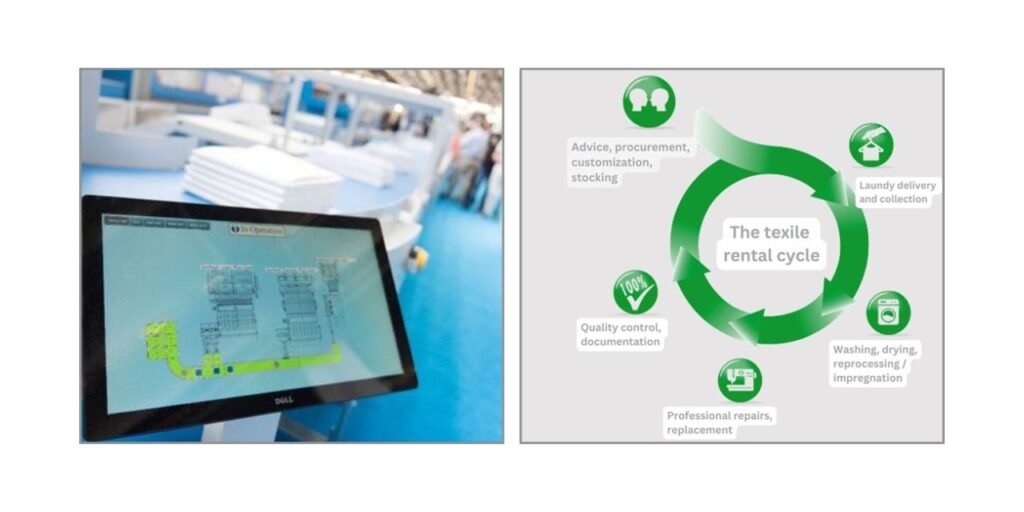
Stuttgart am Main, August 22, 2024. A prime example of a circular, sustainable business model is the professional linen and workwear rental service, which employs durable textiles rather than inferior or disposable goods (reduce), extends their useful life by expert maintenance and repairs (reuse), and devises strategies for finding new uses for them once their useful lives are over (recycle).
The European Commission has started the process of converting the apparel manufacturing sector from a short-lived consumer business model to a more sustainable, circular economy, among other things, via its “Green Deal.” By 2030, textile items with a longer life cycle will gradually replace fast fashion, helping to reduce environmental pollution. Textiles need to be more resilient, reusable, repairable, recyclable from fiber to fiber, and include a higher percentage of recycled fibers in order to meet this objective. The circularity requirements established in Brussels have long been standard procedure for the textile-service industry because precisely these qualities—durability, washability, and ease of repair—are required when renting out protective gear, professional workwear, hospital and hotel linen, mop covers, and other items. These characteristics enable rental linen to stay in the service cycle for an extended period of time, solidifying its position as a sustainable substitute for outright purchases.
The circular system’s laundry
The textile-rental service provides a range of solutions designed to meet the requirements of various clientele segments. Textile-service laundries carry a variety of sizes of workwear and protective apparel so that each customer’s staff may be outfitted appropriately. After that, it is labeled and given to the wearer specifically. If the worker quits from the company, the clothes are returned and, if in excellent shape, utilized again as replacement apparel. A pool solution is more typical when it comes to workwear for the healthcare industry, bed linens, table linens, and towels By combining comparable textiles that are provided to several customers or wearers, a laundry pool may drastically cut down on the amount of textiles consumed.
Similar contract textiles, like towels and bed linens, are often placed in a pool and then removed for client delivery in the case of textile rental services. [Source: Messe Frankfurt] Another important aspect of commercial textile care that helps prolong the life of textiles is local textile cleaning, where a variety of commodities are expertly treated on behalf of both commercial and private clients. Exquisite workwear, fine home linens, delicate down coats, and badly filthy outerwear are all cleaned, freshened, and returned to useable condition. Additionally, if stains continue to be a problem even after cleaning, a professional firm may recolor the items to make sure they can be used again.
The advantages of textile leasing services for recycling
In addition to the two primary goals of “reuse” and “repair,” the industry is putting a lot of effort into recycling used textiles, as mandated by the EU textile policy. Numerous manufacturers of workwear have created their own return policies, allowing consumers to return used clothing in exchange for new purchases. Partner organizations then recycle or use the worn workwear. Big businesses have also implemented a centralized system for workwear returns and recycling, such as Deutsche Telekom and Ikea. In fact, the furniture behemoth has used used workwear to create its own collection of home textiles.Nonetheless, using a rental service is the most straightforward approach to put such a system into place because the products are always brought back to the specialized business and sorted there. Stated differently, after washing, old laundry is gathered in one location and combined with other comparable waste textiles to make a sizable volume. This considerably streamlines the logistics of both collecting and recycling. Due to these favorable circumstances, a pilot program has already been launched by which a number of textile service providers combine their leftover hotel linens and direct them toward industrial cotton-to-pulp recycling. These activities, whether solo or collaborative, demonstrate the industry’s dedication to creating solutions for “waste materials.”
Upcycling textiles to create designer goods
Rejected textiles may be used for many purposes besides recycling. For instance, the Swedish business Fristads provides workwear repair services. John Lewis, the British department store company, takes it a step further. Customers can submit their clothing for cleaning and mending to certain businesses as part of a field experiment. The Timpson Group’s Johnsons laundry and dry cleaning network handles the processing of the clothing. Additionally, designers have seen prospects for repurposing old contract fabrics and workwear. As an illustratio They disassemble and reassemble objects from their collections, or they adorn them with ornate ornamentation. After being artistically improved, the products are reintroduced to the market as designer goods. Large contract fabrics can also be recycled and turned into cosmetic items, purses, or small quantities of aprons after being dyed a different color. But the impact of these ideas on cutting down on textile waste is only as great as their diversity. The only model that can bring bigger amounts back into the economic cycle is the well-established second-hand model.
Cons and advantages of repurposed materials
Although the textile-care sector is united in its support of the EU textile strategy’s criteria and in offering solutions, it is divided on the issue of raising the percentage of recycled fibers in its products. While many workwear collections and hotel linen lines already satisfy Brussels’ criteria, other goods fail to fulfill durability standards as the quality of the fiber deteriorates with each recycling step. To assure longevity in industrial washing, many contract-textile producers continue to depend only on virgin, brand-new fiber materials. The industry has the ideal forum to go into great detail about this conflict of interest thanks to Texcare International
Visit www.texcare.com for more details about the premier global trade show for textile care. Messe Frankfurt organizes trade shows and conferences for the textile-care industry in all of the world’s main economic zones in addition to Texcare International. the brand at www.texcare.com
